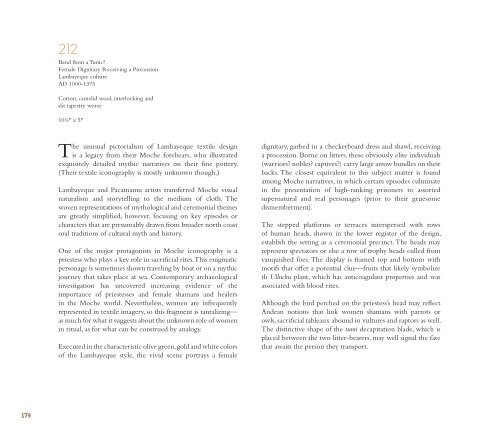Create successful ePaper yourself
Turn your PDF publications into a flip-book with our unique Google optimized e-Paper software.
212<br />
Band from a Tunic?<br />
Female Dignitary Receiving a Procession<br />
Lambayeque culture<br />
AD 1000-1375<br />
Cotton, camelid wool; interlocking and<br />
slit tapestry weave<br />
10½" x 5"<br />
The unusual pictorialism of Lambayeque textile design<br />
is a legacy from <strong>the</strong>ir Moche forebears, who illustrated<br />
exquisitely detailed mythic narratives on <strong>the</strong>ir fine pottery.<br />
(Their textile iconography is mostly unknown though.)<br />
Lambayeque and Pacatnamu artists transferred Moche visual<br />
naturalism and storytelling to <strong>the</strong> medium of cloth. The<br />
woven representations of mythological and ceremonial <strong>the</strong>mes<br />
are greatly simplified, however, focusing on key episodes or<br />
characters that are presumably drawn from broader north coast<br />
oral traditions of cultural myth and history.<br />
One of <strong>the</strong> major protagonists in Moche iconography is a<br />
priestess who plays a key role in sacrificial rites. This enigmatic<br />
personage is sometimes shown traveling by boat or on a mythic<br />
journey that takes place at sea. Contemporary archaeological<br />
investigation has uncovered increasing evidence of <strong>the</strong><br />
importance of priestesses and female shamans and healers<br />
in <strong>the</strong> Moche world. Never<strong>the</strong>less, women are infrequently<br />
represented in textile imagery, so this fragment is tantalizing—<br />
as much for what it suggests about <strong>the</strong> unknown role of women<br />
in ritual, as for what can be construed by analogy.<br />
Executed in <strong>the</strong> characteristic olive green, gold and white colors<br />
of <strong>the</strong> Lambayeque style, <strong>the</strong> vivid scene portrays a female<br />
dignitary, garbed in a checkerboard dress and shawl, receiving<br />
a procession. Borne on litters, <strong>the</strong>se obviously elite individuals<br />
(warriors? nobles? captives?) carry large arrow bundles on <strong>the</strong>ir<br />
backs. The closest equivalent to this subject matter is found<br />
among Moche narratives, in which certain episodes culminate<br />
in <strong>the</strong> presentation of high-ranking prisoners to assorted<br />
supernatural and real personages (prior to <strong>the</strong>ir gruesome<br />
dismemberment).<br />
The stepped platforms or terraces interspersed with rows<br />
of human heads, shown in <strong>the</strong> lower register of <strong>the</strong> design,<br />
establish <strong>the</strong> setting as a ceremonial precinct. The heads may<br />
represent spectators or else a row of trophy heads culled from<br />
vanquished foes. The display is framed top and bottom with<br />
motifs that offer a potential clue—fruits that likely symbolize<br />
th Ulluchu plant, which has anticoagulant properties and was<br />
associated with blood rites.<br />
Although <strong>the</strong> bird perched on <strong>the</strong> priestess’s head may reflect<br />
Andean notions that link women shamans with parrots or<br />
owls, sacrificial tableaux abound in vultures and raptors as well.<br />
The distinctive shape of <strong>the</strong> tumi decapitation blade, which is<br />
placed between <strong>the</strong> two litter-bearers, may well signal <strong>the</strong> fate<br />
that awaits <strong>the</strong> person <strong>the</strong>y transport.<br />
174







